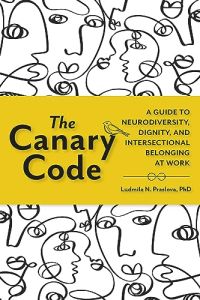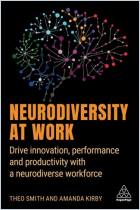Acesse a sua conta getAbstract para obter o resumo!

Acesse a sua conta getAbstract para obter o resumo!
Ludmila Praslova
The Canary Code
A Guide to Neurodiversity, Dignity, and Intersectional Belonging at Work
Berrett-Koehler, 2024
Sobre o que é?
Create an inclusive work space for neurodivergent employees — and leaders — to tap into new heights of productivity.
Recommendation
Many neurodivergent workers have missed out on job opportunities and had employers mismanage their talents because they don’t fit the status quo. For these workers, companies’ embrace of greater flexibility during COVID-19 was a boon that allowed them to flourish. Professor Dr. Ludmila Praslova offers insights into fostering an inclusive workplace that celebrates neurodiversity and intersectional dignity. Discover practical strategies to create environments where everyone feels valued and respected. Learn how to break down barriers and implement effective policies that support diverse talent.
Take-Aways
- Inclusive workplaces support diverse interaction, communication, and productivity styles by challenging neuronormative standards.
- The “Canary Code” framework promotes inclusivity for neurodivergent employees.
- Make hiring and onboarding more inclusive by understanding the needs of neurodivergent employees.
- Heed employee input on office space design and workflow flexibility.
- Create psychologically safe workspaces by listening, communicating clearly, and aiming for objective performance reviews.
- Neurodivergent leaders should use their influence and power to create more inclusive workspaces for all.
Summary
Inclusive workplaces support diverse interaction, communication, and productivity styles by challenging neuronormative standards.
Neurodiversity acknowledges the vast variations in human cognition, emotion, and perception, including neurodivergent conditions such as ADHD, autism, and dyslexia. Myths about neurodiversity, such as assuming all neurodivergent individuals share the same traits, perpetuate exclusion in the workplace. These myths lump people together while ignoring neurodivergent needs and preferences.
“A holistic approach to inclusion is likely to be the key to belonging for everyone — and belonging is the key to retention, productivity, and engagement.”
To enable neurodivergent employees to do their best work, organizations must create flexible, inclusive environments that respect individual differences in social, cognitive, emotional, and sensory needs. For example, hiring standards prioritizing a candidate’s ability to maintain eye contact or not fidget can disadvantage otherwise qualified neurodivergent applicants.
Creating a receptive environment for neurodivergent employees involves rethinking traditional workplace socialization to allow for varied communication preferences and levels of interaction. For instance, companies might allow employees to opt out of workplace social events. Organizations should support diverse productivity styles by enabling flexible work schedules and environments, such as providing quiet spaces for sensory-sensitive employees or more stimulating areas for “sensory-seeking” individuals.
The “Canary Code” framework promotes inclusivity for neurodivergent employees.
Neurodivergent employees, like canaries in coal mines, are often the first to detect and feel the effects of poorly designed workplace systems and toxic employment environments. For example, unstructured interview questions focusing on non-work topics like golf can disproportionately disadvantage neurodivergent applicants, as many thrive on structure and predictability. Ignoring these individuals’ concerns or refusing to hire them based on “culture fit” perpetuates hiring inefficiencies for other groups, too, such as minorities and those whose backgrounds differ from the interviewer’s. When problematic practices like biased promotion structures or workplace bullying go unchallenged long term, companies’ abilities to hire and retain top workers and avoid reputational damage suffer.
“Inclusion is not bringing people into what already exists; it is making a new space, a better space for everyone.” (Professor George Dei)
Organizations that adopt the six Canary Code principles ensure an inclusive, more productive workplace:
- “Embedding employee participation” — Involve marginalized employees in decision-making. For example, at Deloitte, involving neurodivergent employees in designing hiring programs improved onboarding processes and increased employee engagement.
- Focusing on outcomes — Allow for and support a range of ways of working, allowing people to accomplish their tasks in the ways that work best for them. The dance company Infinite Flow hires dancers others would likely pass on — including those who are deaf or in wheelchairs. These factors matter less to the company’s founder, Marisa Hamamoto, than whether a dancer can create something beautiful and evoke the desired emotions in the audience.
- Ensuring flexibility — Reject policies that aim to standardize the “time, place, and style” of work. The law firm Legalite encourages its employees to create work schedules that maximize their talents and allow them to easily meet their personal obligations, such as caring for children. This approach has resulted in high employee satisfaction and retention and allowed them to tailor services to clients to boost their bottom line.
- Promoting organizational justice — Fair and equitable practices improve organizational outcomes and employees’ morale and sense of belonging. Call center company Call Yachol designed its hiring process to reduce anxiety and seeks candidates from underemployed populations, including former convicts, people with disabilities, and older people. Managers work to ensure employees have the accommodations they need to thrive.
- Maintaining transparency — Clear communication promotes psychological safety and boosts performance. The software company Ultranauts maintains transparency by clearly communicating promotion criteria and making company performance indicators visible to all team members. This fosters trust and collaboration.
- Using appropriate decision-making tools — Objective hiring and job performance measures ensure a level playing field for all. The computer company Dell’s neurodiversity program’s skills-focused interviews — which provide candidates with questions in advance — encourage neurodivergent candidates to showcase their abilities.
Make hiring and onboarding more inclusive by understanding the needs of neurodivergent employees.
Neurodivergent individuals often face biases in the hiring process. For example, high-stress interview tactics that aim to catch applicants in lies can cause neurodivergent candidates to appear dishonest or flustered despite their honesty. Neurodivergent candidates also face disadvantages when job descriptions emphasize neuronormative social expectations and personality traits — such as being outgoing or dynamic — which may not be relevant to the job.
“Highly specialized work calls for highly specialized minds.” (Agricultural engineer Temple Grandin)
To “de-bias” the hiring process, conduct thorough analyses to ensure job descriptions accurately reflect the position’s requirements. Focus more on outcomes than methods. Separate essential qualifications from desirable ones and avoid listing generic or unnecessary qualifications that discourage qualified candidates. Job descriptions should employ plain language, avoid jargon, and specify the context of required skills, such as differentiating between written and verbal communication needs. Organizations should structure the interview process to evaluate candidates on their abilities to perform job-related tasks rather than on their abilities to handle stress or engage in small talk.
Onboarding should help integrate new employees into the organization, shaping their enthusiasm, commitment to the organization, and future performance. To make onboarding inclusive for neurodivergent employees, organizations can implement a quality “preboarding” experience that helps them understand new hires’ needs and provides clear information. For example, offering a workplace visit before a new hire’s first day of work can alleviate anxiety and help new hires feel more comfortable. Providing a mentor or implementing a buddy system for support and guidance can, likewise, help neurodivergent employees navigate a new work environment more effectively. Inclusive onboarding should include tailored training methods, such as providing instructional materials in multiple formats to cater to diverse learning styles and pacing the content to prevent cognitive overload.
Heed employee input on office space design and workflow flexibility to create inclusive work environments.
Inclusive office spaces accommodate a wide range of sensory, physical, and cognitive needs. Engage employees with diverse needs in the design process to ensure your workspace supports everyone. For example, the BBC Cymru Wales New Broadcasting House in Cardiff incorporated feedback from neurodivergent employees to design a workspace with neutral colors, various textures, ample natural light, and quiet areas for those prone to sensory overload.
Inclusive office design emphasizes flexibility, allowing employees to adjust spaces for their individual requirements by, say, providing extra lighting or soundproofing specific areas. Organizations should prioritize comfort and aesthetics for all employees and avoid one-size-fits-all solutions that might exclude certain groups. Ensuring that furniture and workstations are accessible and adjustable for people with disabilities or those who prefer different working conditions reflects a commitment to inclusion.
“Holistic belonging applied to the work environment means understanding that our performance, health, and well-being are significantly influenced by workspaces.”
Flexibility in work arrangements enhances productivity for neurodivergent employees by allowing them to work during their most productive hours and in environments where they feel most comfortable. Offering flexible schedules, remote work options, and hybrid models helps employees manage distractions and focus better. Workload flexibility, such as part-time positions and splitting job responsibilities with other employees, enables employees to balance their energy levels and personal responsibilities.
Create psychologically safe workspaces by listening, communicating clearly, and aiming for objective performance reviews.
A toxic work environment features noninclusive, disrespectful, unethical, cutthroat, and abusive behaviors. Managers may make belittling comments or expect employees to read unspoken wishes, creating a hostile atmosphere. Allowing unethical behaviors to go unchecked or prioritizing short-term wins over long-term health and productivity affects all employees’ well-being and performance. For example, a workplace that perpetuates neuroexclusion, where employees who differ from the norm experience bullying or unrealistic expectations, will eventually see its entire work culture decline, leading to high turnover among all its workers.
To make a toxic work environment more inclusive, foster widespread engagement. Ensure all employees can express their perspectives through forums and surveys, implement flexible work practices, and maintain honest and transparent communication.
“The best way to make performance management fair is to build fairness into systems that scaffold everyday work interactions.”
Psychological safety means employees feel safe expressing themselves authentically. Performance reviews can be problematic for neurodivergent employees because they often receive personality-focused feedback that implies their natural traits are unacceptable. For example, managers may criticize autistic employees for their direct communication styles, which are intrinsic to their identities. To ensure that reviews are inclusive, focus on objective, outcome-based criteria that align with the employee’s strengths and job performance instead of subjective personality traits. Involve neurodivergent employees in setting performance goals and provide flexibility in how they achieve them.
Neurodivergent leaders should use their influence and power to create more inclusive workspaces for all.
Neurodivergent leaders face daunting myths and stigmas. Many organizations believe a good leader fits a specific, neurotypical mold, that a singular “pipeline” for career progression exists, and that all employees must fit into a company’s existing culture. These myths limit companies’ recognition and development of diverse leadership talents. Organizations can overcome these barriers by creating growth tracks that leverage individual strengths, such as offering specialized roles in people management, systems and processes, strategy, and expert leadership. Companies can unlock innovation, improve morale, and build more resilient and inclusive leadership teams by fostering a culture that values diverse perspectives and strengths.
“In most cases, we are not overcoming our “conditions.” We are overcoming discrimination on the basis of our differences and the resulting internalized stigma.”
As a neurodivergent leader, overcoming biases requires leveraging unique experiences and fostering an inclusive environment. One effective strategy is to embrace your distinct problem-solving skills and demonstrate their value in addressing complex issues. Another approach embraces fostering empathy and inclusivity within your team. These are strengths neurodivergent leaders often naturally possess, and they enhance team cohesion and productivity.
Create a more inclusive work environment by leveraging your influence as a leader. By remaining authentic and trusting in your unique perspective and expertise, you can inspire others and lead by example, thus encouraging a culture of acceptance and understanding. Sharing your experiences as a neurodivergent person and sharing your knowledge about neurodivergence educates your team and fosters an environment that values and includes everyone. Focus on transparent communication and emphasize the value of diverse viewpoints to influence organizational change and promote a more inclusive culture.
About the Author
Dr. Ludmila Praslova is a Professor and the Founding Director of Graduate Programs in Organizational Psychology at Vanguard University.
This document is restricted to personal use only.


















Comment on this summary